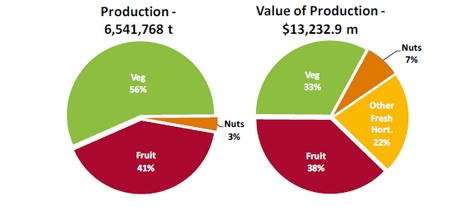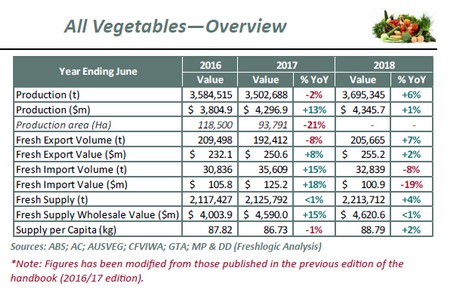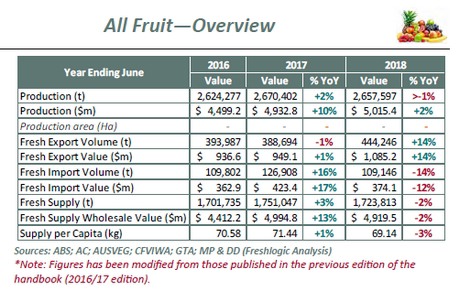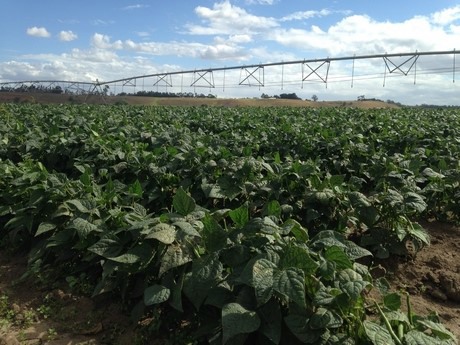The value of both Australian fruit and vegetables has increased over the 2017-18 financial year, according to data from Hort Innovation's Australian Horticulture Statistics Handbook, released this month.
While fruit showed a two per cent rise in value, it was slightly down on production volumes, but vegetables had an increase in volume to correspond with the rise in value.

Graphic source: Australian Horticulture Statistics Handbook (Hort Innovation)
The Handbook features information drawn from several supply chain and trade sources and it includes data on more than 70 horticultural products including fruit, nuts, vegetables, nursery, turf and cut flowers. Nationally, almonds were Australia’s most valuable horticultural export product ($440 million) followed by table grapes ($384m), oranges ($280m) macadamias ($266m), and mandarins ($139m).
For the year ending June 2018, nearly 3.7 million tonnes of vegetables were produced (up 6 per cent on previous year) with a value of $4.35 billion (one per cent increase). Overall vegetable exports increased by seven per cent to 205,665 tonnes, with a two per cent increase in value.
Production of garlic was up 26 per cent to 2,246 tonnes, tomatoes was up 14 per cent to 484,073 tonnes, sweet potatoes increased by 11 per cent to 97,222 tonnes, and beans were up 17 per cent to 33,890 tonnes.

Graphic source: Australian Horticulture Statistics Handbook (Hort Innovation)
In terms of value, there were mixed results across vegetable varieties; herbs were up 15 percent to $176.9m despite only a one per cent increase in volume. It was a similar story for eggplant, which was 18 per cent up in value, with less than one per cent volume rise. On the other hand, cucumbers increased volume by 4 per cent but lost 14 per cent value, and Cauliflower experienced a 10 per cent drop in value, despite 10 per cent rise in volume.
Garlic had a 19 per cent rise in value to $15.6m, to reflect a rise in volumes. Asparagus actually had a 6 per cent drop in volume, with a 15 per cent rise in value to $61m.
Meanwhile, nearly 2.66 million tonnes of fruit were produced in Australia (down less than 1% on the previous year), with the value of production $5.02 billion (2% increase). However, there was a 14 per cent growth in fruit exports in terms of volume and value.
There was massive growth in cherries from the previous year, with a 42 per cent rise in volumes to 15,560 tonnes and jump in value to $148.7m, while Mangoes recorded a 36 per cent rise in volumes to 83,315 tonnes, Lemons and Limes were up 16 per cent to 47,950 tonnes, and blueberry volumes were up by 42 per cent to 16,850 tonnes, and an increase in value to $309m.

Graphic source: Australian Horticulture Statistics Handbook (Hort Innovation)
In terms of value, Kiwifruit had a strong increase of 28 per cent to $26.3m despite a downturn of two per cent in volumes, Summerfruit had an increase of 12 per cent in volume, but value increased by less than one per cent. Volumes of persimmons increased by less than one per cent, but the value jumped by 11 per cent to $11.6m. Both the volume and value of Nashis increased by 40 per cent, while the value of melons was down by 28 per cent to $124.2m, and strawberries also had a 12 per cent lower value compared to the previous year.
Avocados had a 17 per cent increase in volume, which led to a 45 per cent increase in value to $543m - although the volumes of export were down by 23 per cent.
Victoria was the nation’s leading fresh exporter accounting for 47 per cent of the total value of horticultural exports, valued at almost $997m. The largest export markets for fresh Australian horticultural products by value were Asia (72 per cent), followed by Europe (9 per cent) and the Middle East (9 per cent).

In the 2017/18 financial year, fresh horticulture exports were valued at $2.15 billion - around 6 per cent higher than in the previous year.
"This equated to around 746,344 tonnes of fresh produce and accounts for 11 per cent of total production volume," Hort Innovation General Manager for Research, Marketing and Investment, David Moore said. "It tells us that of the $13.2 billion of total value produced across all Australian horticulture industries, Asia was the primary export destination of fresh Australian produce, amounting to over 535,135 tonnes at a value of over $1.5 Billion. The data determines that the increase in export value was primarily driven by citrus exports, with cherries, summerfruit, walnuts and carrots also showing strong growth. At a local level, the data tells us that Australian vegetable growers produced almost 3.7 million tonnes of fresh produce in the year ending June 2018.”
In terms of domestic consumption, 98 per cent of Australian households purchased fruit, while the vegetable supply per capita was 88.8kg.
To view the full handbook visit: Hort Innovation Website
